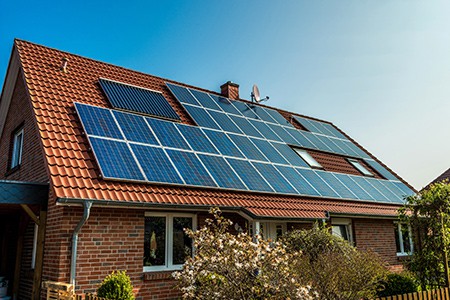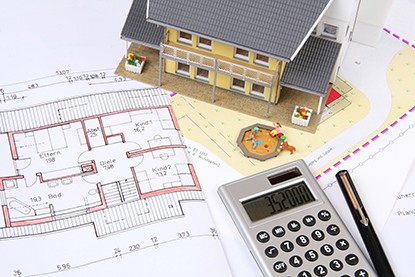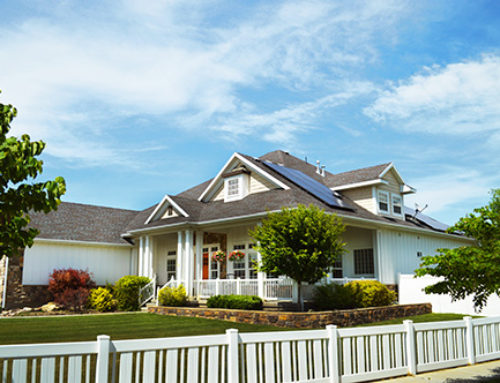A home solar array is one of the most increasingly popular ways to generate electricity for your home and rely less on the local utility to provide power.

A solar cell system is no small undertaking and requires a great deal of consideration and planning. One of the biggest questions that homeowners often have is, “How many solar panels would it take to run my home on renewable energy?” Because every home is slightly different, there is no one cookie-cutter answer to this question.
Instead, we can look into some of the determining factors for creating solar panel homes. Here’s what you should ask to determine how many solar panels it would take to run your home.
Do You Live In Your Home Year Round?
A solar system’s size depends on how often you or a family member are occupying a home.

Some homeowners use a vacation home for the winter and then move back north in the summer. This is important to consider because it can drastically change the sizing of your solar installation. If you are only planning to live in one home during the summer months, you may be able to build a smaller solar panel installation. There is more sunlight each day in the summer, and you can maximize your energy efficiency.
If you plan to live in a home run by solar in the winter, it may need to be sized larger to account for fewer hours of sunlight each day. Because the sun’s energy varies by the time of day, solar modules also produce different amounts of clean energy. Solar panel efficiency is affected by what time of year the PV system is generating solar electricity.
What Is Your Average Annual Energy Load?
One of the most important factors determining the size of a solar energy system is your average annual energy load.
Energy load is the amount of energy that your solar power system would need to produce to entirely offset fossil fuel or utility-generated energy. Work out kilowatt hours usage by tracking your monthly electric bill. This way, you will see how your energy usage fluctuates throughout the year. Typically, homes use far more electricity in the summer (mostly cooling) than in the winter. For reference, the average single-family home in the United States consumes just under 11,000 kilowatt-hours of energy per year, but your specific consumption may be higher or lower.
Are You Looking For A Grid That’s Connected Or Off The Grid Solar Project?
A home solar array connected to the grid may look far different from one off the grid. A solar utility company will have input on your solar system if it’s grid-tied, but none whatsoever if it is off the grid.

A solar power generator with backup batteries and inverter is one of the most common ways to live off the grid. Typically, the batteries will charge all day while the sun is shining, and discharge at night when the sun goes down. This system provides an electric current even while the sun’s rays are not actively feeding your solar electric system. There are advantages to both of these systems.
You will need to oversize an off grid solar system to account for extended periods of little sunlight to ensure you will always have the necessary power. With grid-connected systems, a smaller system is fine because the grid is always there to make up for any shortcomings of the solar system. As the price of solar cells falls, it is gradually becoming more cost-effective to install larger systems to meet the home’s full demand.
Do You Live In A State That Allows Net Metering?
Because the sun doesn’t shine around the clock, there will be times when you are pulling energy from your solar utility company. Luckily, many states include a net metering policy, allowing homeowners to export excess solar energy to the grid when they are producing more than they are using. Then, this exported energy is credited back to your electricity bill at the end of every month.
The utility will be working out kilowatt hours on your bill, so you won’t ever have to worry about it. The advantage to states like this is that you do not lose any of the solar power generator’s value when its energy is exported. In other states without net metering solar laws, exported solar may only be valued at the wholesale rate instead of a regular resale rate. Net metering solar out to the grid also acts as a solar battery without actually purchasing one, which can be quite expensive. States with net metering laws typically already have the solar technology infrastructure to accommodate photovoltaic energy flowing through a home.
And be sure to check out the federal tax credit, which usually stacks benefits with your state’s solar incentive.
What Is A Rough Calculation To Determine The Number Of Panels?
While there are various solar PV tools that can be used to design a solar system for your home, they are often expensive, and hiring someone to do it can also get pricey.
Instead, some rough calculations can get you in the ballpark of what solar system size fits your entire home electricity usage. First, you must decide what solar cell wattage you will use on your home. Some free solar PV tools will be able to show you common wattages and estimated prices for them. You will quickly notice that higher wattage and more efficient solar panels are more expensive, which will raise the total cost of the solar system project but may prove to be worth it in the long term.

For the cases of this example, we will consider a 365 watt PV panel. Next, we will assume that this panel gets 8 hours of sunlight per day on your rooftop. A 365-watt panel receiving 8 hours of sunlight per day will produce almost 3 kilowatt-hours per day. This, multiplied by 365 days per year results in a solar output of roughly 1,095 kilowatt-hours annually.
Next, we’ll look at the average consumption of a single-family home. Most recent data suggests that a typical home consumes just under 11,000 kilowatt-hours annually. So, when we divide our total consumption by the expected output of one photovoltaic cell, we see that roughly ten solar panels of this size would be enough to power the home. Ten traditional solar panels at a size of 365 watts per panel means an on/off grid solar system of around 3.65 kilowatts.
Of course, this number can be higher or lower depending on your average amount of sunlight, personal energy usage, and other factors. It is also important to remember that there are some losses involved in solar energy usage, and thus you may need to slightly oversize the solar system to account for this.
Solar power infrastructure is booming in commercial and residential spaces. Thanks to the falling cost of solar paired with robust financial incentives at both the federal and state levels, PV cells’ price is lower than ever before. This leads many homeowners to install residential solar panels that would meet or exceed their home electricity usage. By carefully considering all of the factors that go into solar energy usage, homeowners can better understand how they can make the switch to solar.

[…] How many solar panels do I need to run my house? […]